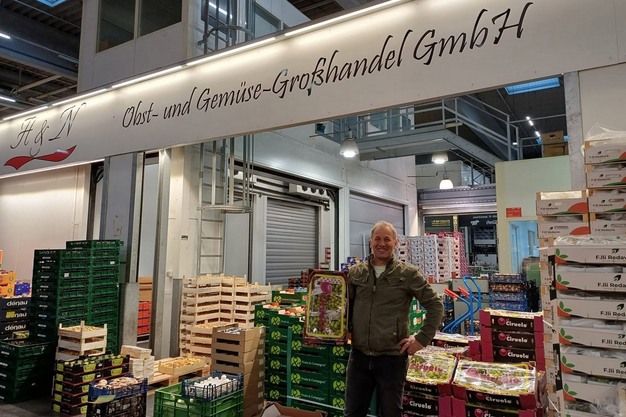The first table grapes have been gradually arriving from the gardens in southern Italy since the beginning of July. "We can already offer our customers the better early varieties, such as the light-coloured Arra 30 grape. Nevertheless, the quality was quite variable in the first few weeks of the season, meaning that there was sometimes a slightly weaker batch. But that's normal at the start of the season," says Hasan Shabani, grape merchant at the Frankfurt Fresh Produce Centre and Managing Director of H&N Obst und Gemüse Großhandel Ltd, which was founded there in 2012.
Spanish Itumeight variety is gaining in importance
Grapes are one of the wholesale company's main products, emphasises Shabani, who sources the majority of his grapes from Dutch importer Direct Source International. "During the Italian high season, we sell up to 15–16 pallets a day and have around 7-8 different varieties to choose from so that we can offer every customer a suitable grape." In addition to table grapes of Italian origin, Shabani also offers Spanish fruit. "Although the Spanish export season is much shorter than the Italian one, I think the export volume is increasing. In addition to various light-coloured, seedless grapes, we have also been offering the red Itumeight grape for a few years now, which is becoming increasingly popular with our customers."
 Like many other products, grapes have also become significantly more expensive in recent years. "We are estimated to be 30 per cent above the pre-Covid price levels," says Shabani, who mainly counts weekly market traders and specialist shops among his customers.
Like many other products, grapes have also become significantly more expensive in recent years. "We are estimated to be 30 per cent above the pre-Covid price levels," says Shabani, who mainly counts weekly market traders and specialist shops among his customers.
Red grapes dominate the market
Traditionally, the Italian grape campaign only really picks up speed after the summer holidays. The peak season is still centred on the period from September to the beginning of December, when the popular Italia and Muscat grapes, among others, are on offer. Shabani: "Nowadays, the proportion of seedless grapes is around 80 per cent, whereas 15 to 20 years ago, seeded grapes were quite far ahead. The world is changing and so are the needs of our customers. The demand for Turkish Sultana grapes, for example, has been declining sharply for several years, which is probably due to the large number of good quality seedless grapes from other countries. In addition, blue grapes have lost importance in favour of red grapes." According to Shabani, the market share of light-coloured grapes is relatively stable.
For more information:
Hasan Shabani
H&N Obst und Gemüse Großhandel GmbH
Frischezentrum Frankfurt
Tel: +49 151-61011633
Email: [email protected]
